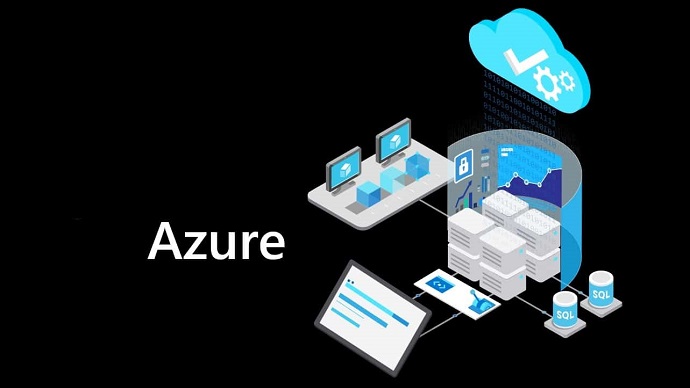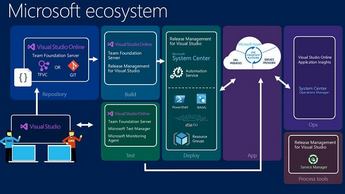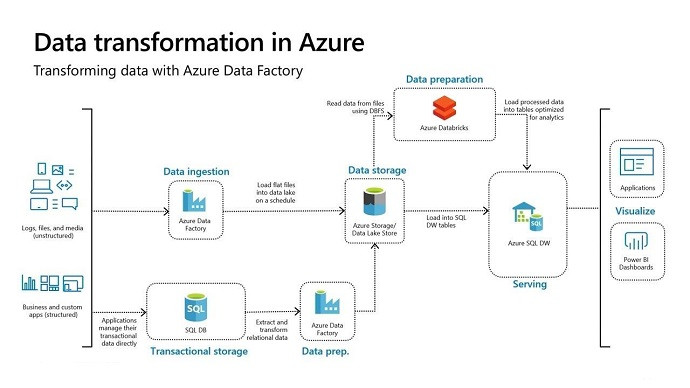
AZ-305: Designing Microsoft Azure Infrastructure Solutions
PDFs and exam guides are not so efficient, right? Prepare for your Microsoft examination with our training course. The AZ-305 course contains a complete batch of videos that will provide you with profound and thorough knowledge related to Microsoft certification exam. Pass the Microsoft AZ-305 test with flying colors.

Curriculum for AZ-305 Certification Video Course
| Name of Video | Time |
|---|---|
 1. Welcome! |
3:36 |
 2. Overview of the AZ-305 Exam Requirements |
6:50 |
 3. Azure Free Account |
4:51 |
| Name of Video | Time |
|---|---|
 1. Design Identity, Governance, and Monitoring Solutions (25-30%) |
1:54 |
 2. Cosniderations for Log Routing |
12:13 |
 3. Introduction to Azure Monitor |
3:42 |
 4. Monitoring App Services with Application Insights |
11:23 |
 5. Monitoring Virtual Machines |
5:10 |
 6. Monitoring Storage Accounts |
2:13 |
 7. Azure Monitor Alerts and Metrics |
7:45 |
 8. Azure Monitor Log Queries (Kusto) |
7:04 |
 9. *NEW* Azure Sentinel for Security Monitoring |
8:27 |
| Name of Video | Time |
|---|---|
 1. Role Based Access Control (RBAC) |
10:26 |
 2. Identity Management in Azure |
12:31 |
| Name of Video | Time |
|---|---|
 1. Intro to Azure Active Directory |
5:26 |
 2. Create a New Azure Active Directory |
3:54 |
 3. Intro to Authentication |
8:19 |
 4. AD Synchronization |
2:14 |
 5. *NEW* Azure AD Connect Cloud Sync |
4:59 |
 6. Protecting Authentication |
5:02 |
 7. Self-Service Password Reset |
7:48 |
| Name of Video | Time |
|---|---|
 1. Introduction to Authorization |
4:28 |
 2. Approach to Authorization |
8:38 |
 3. Azure AD Groups and Roles |
4:42 |
 4. Just In Time (JIT) Access |
2:25 |
 5. *NEW* Azure Resource Graph |
4:49 |
| Name of Video | Time |
|---|---|
 1. *NEW* Azure Policy |
3:20 |
 2. *NEW* Assign a Policy |
5:52 |
 3. *NEW* Azure Blueprint |
5:27 |
| Name of Video | Time |
|---|---|
 1. Design data storage solutions (20–25%) |
2:36 |
 2. Managed and Unmanaged Data Strategy |
5:36 |
 3. Relational and NoSQL Database Strategy |
6:19 |
 4. Database Auditing Strategy |
2:48 |
 5. The Concept of DTUs |
2:01 |
 6. The Concept of RU/s |
2:18 |
 7. Data Retention Strategy |
1:47 |
 8. Data Availability, Consistency and Durability |
4:04 |
 9. Data Warehouse Strategy |
1:07 |
| Name of Video | Time |
|---|---|
 1. Data Geo-Replication |
4:10 |
 2. Data Encryption |
4:00 |
 3. Data Scaling |
3:57 |
 4. Data Security |
6:10 |
 5. Data Loss Prevention (DLP) |
6:01 |
| Name of Video | Time |
|---|---|
 1. Data Monitoring Strategy |
4:33 |
| Name of Video | Time |
|---|---|
 1. Design business continuity solutions (15–20%) |
2:31 |
 2. Introduction to Azure Site Recovery (ASR) |
5:29 |
 3. Testing Failover and Initiating Failover |
4:25 |
 4. ASR Supported Workloads |
2:29 |
 5. ASR Geographies and Paired Regions |
3:22 |
| Name of Video | Time |
|---|---|
 1. Application Redundancy |
4:52 |
 2. High Availability for Essential Components |
3:08 |
 3. Storage Types for High Availability |
3:08 |
 4. *NEW* Essential High Availability Concepts for Exam |
9:48 |
 5. *NEW* DEMO: Deploying an HA Zone-Redundant Solution |
11:46 |
 6. *NEW* High Availability Non-Relational Storage |
15:12 |
 7. *NEW* High Availability Relational SQL Database |
13:28 |
| Name of Video | Time |
|---|---|
 1. Storage Account - Data Archiving and Access Tiers |
3:49 |
 2. Access Tier Requirements |
5:19 |
 3. Access Tier Service Level Agreements (SLAs) |
2:53 |
| Name of Video | Time |
|---|---|
 1. Design Infrastructure (25-30%) |
1:00 |
 2. Compute Deployments |
4:08 |
 3. Container Deployments |
3:22 |
 4. Storage Deployments |
1:57 |
 5. Web App Deployments |
1:55 |
 6. Service Fabric Deployments |
2:15 |
| Name of Video | Time |
|---|---|
 1. Azure Migration Strategy |
4:59 |
 2. Data Migration Strategy |
6:36 |
 3. Application Migration Strategy |
4:28 |
 4. *NEW* Storage Migration Service |
3:11 |
| Name of Video | Time |
|---|---|
 1. API Management |
5:42 |
 2. API Policies |
4:18 |
| Name of Video | Time |
|---|---|
 1. Storage Account Strategy Overview |
11:38 |
 2. Setting Access Tiers |
7:01 |
 3. Storage Requirements |
5:39 |
 4. Storage Management |
3:22 |
| Name of Video | Time |
|---|---|
 1. Overview of Compute |
2:56 |
 2. Compute Options |
7:22 |
 3. High Performance Compute (HPC) |
4:00 |
 4. *NEW* Windows Virtual Desktop |
3:53 |
| Name of Video | Time |
|---|---|
 1. Overview of Networking in Azure |
6:39 |
 2. The Hub and Spoke Networking Topology |
6:47 |
 3. Virtual WAN Networking Topology |
4:47 |
 4. Azure Public DNS |
5:27 |
 5. Azure Private DNS |
2:47 |
 6. Private Endpoints |
7:39 |
 7. Private Link Service |
4:11 |
 8. Overview of Azure Load Balancing Services |
9:04 |
Microsoft AZ-305 Exam Dumps, Practice Test Questions
100% Latest & Updated Microsoft AZ-305 Practice Test Questions, Exam Dumps & Verified Answers!
30 Days Free Updates, Instant Download!
AZ-305 Premium Bundle

- Premium File: 328 Questions & Answers. Last update: Dec 3, 2025
- Training Course: 87 Video Lectures
- Study Guide: 933 Pages
- Latest Questions
- 100% Accurate Answers
- Fast Exam Updates
Microsoft AZ-305 Training Course
Want verified and proven knowledge for Designing Microsoft Azure Infrastructure Solutions? Believe it's easy when you have ExamSnap's Designing Microsoft Azure Infrastructure Solutions certification video training course by your side which along with our Microsoft AZ-305 Exam Dumps & Practice Test questions provide a complete solution to pass your exam Read More.
Azure Solutions Architect AZ-305: Complete Training and Exam Guide
AZ-305 Course: Designing Azure Infrastructure Solutions for Certification Success
Course Overview
The Microsoft AZ-305 training course is designed to equip IT professionals and aspiring cloud architects with the skills and knowledge required to design effective solutions on Microsoft Azure. This course is ideal for individuals looking to enhance their expertise in cloud architecture and prepare for the AZ-305 certification exam. With the growing adoption of cloud technologies across industries, the demand for skilled Azure solutions architects has increased significantly. Professionals who complete this training will be well-prepared to design and implement cloud solutions that meet both business and technical requirements.
This course covers a comprehensive set of topics, from understanding the fundamental principles of cloud computing to designing secure, scalable, and highly available solutions on Microsoft Azure. Through practical exercises, learners will gain hands-on experience with real-world scenarios, enabling them to apply their knowledge effectively. Participants will also learn how to design cloud architectures that align with organizational goals and industry best practices, making them valuable assets to any enterprise seeking to leverage the power of the cloud.
The curriculum is structured to provide a balance between theoretical understanding and practical application. Each module is designed to build on the previous one, ensuring that learners develop a solid foundation before moving on to more complex topics. The course is suitable for both experienced IT professionals and those new to cloud architecture who want to specialize in Microsoft Azure.
What You Will Learn From This Course
Understanding the role and responsibilities of an Azure solutions architect
Key principles of cloud computing and cloud service models
How to design governance, security, and compliance frameworks on Azure
Best practices for selecting and implementing Azure storage solutions
Strategies for designing scalable compute resources and virtual networks
Techniques for integrating hybrid cloud environments
Approaches to disaster recovery, business continuity, and high availability
Preparing for the Microsoft AZ-305 certification exam through scenario-based learning
Hands-on experience with Azure services and architectural design patterns
Optimizing cloud solutions for performance, cost-efficiency, and reliability
Learning Objectives
By the end of this course, learners will be able to:
Demonstrate a thorough understanding of Microsoft Azure services and capabilities
Analyze business requirements and design appropriate cloud solutions
Implement governance, security, and compliance measures within Azure environments
Choose and configure storage solutions to meet specific data and application needs
Design compute and networking solutions that are resilient, scalable, and optimized for performance
Integrate hybrid and multi-cloud architectures effectively
Develop strategies for disaster recovery, backup, and high availability
Apply best practices in cloud solution design to real-world scenarios
Prepare confidently for the AZ-305 exam by applying knowledge in practice exercises
Understand industry trends and emerging technologies relevant to cloud architecture
Requirements
To make the most of this course, learners should have:
A fundamental understanding of cloud computing concepts
Basic experience with Microsoft Azure or equivalent cloud platforms
Familiarity with networking, storage, and virtualization concepts
General knowledge of security principles and compliance requirements
Willingness to engage in hands-on exercises and real-world scenarios
Access to a Microsoft Azure subscription to practice designing and deploying solutions
While prior experience in cloud architecture is beneficial, this course is structured to accommodate learners at various skill levels. By providing both theoretical knowledge and practical exercises, participants will gradually develop the expertise required to design and implement effective cloud solutions.
Course Description
The Microsoft AZ-305 training course provides a comprehensive path to mastering cloud architecture on Microsoft Azure. It begins with foundational concepts, including an introduction to cloud computing and the responsibilities of an Azure solutions architect. The course then progresses to advanced topics, such as designing governance frameworks, implementing security measures, and optimizing storage, compute, and network solutions.
Learners will explore real-world architectural scenarios and case studies, gaining practical experience in designing solutions that align with organizational objectives. Emphasis is placed on security, compliance, scalability, performance optimization, and cost management, ensuring that participants can create well-rounded, efficient cloud architectures.
Throughout the course, hands-on labs and exercises reinforce theoretical knowledge. These labs simulate real-life business challenges, giving learners the opportunity to apply their skills in designing and implementing Azure solutions. By the end of the course, participants will have a deep understanding of the principles and practices of cloud architecture, preparing them for the Microsoft AZ-305 certification exam and for a career as an Azure solutions architect.
The curriculum also addresses the dynamic nature of cloud technologies, encouraging learners to stay current with evolving Azure services and emerging trends in cloud computing. This ensures that participants are not only prepared for certification but also for ongoing professional development in a rapidly changing technology landscape.
Target Audience
This course is designed for a wide range of IT professionals, including:
Cloud architects seeking to formalize and expand their expertise
Azure administrators aiming to transition into architecture roles
IT managers responsible for cloud strategy and implementation
Developers who want to understand architectural principles to build scalable applications
Professionals preparing for the Microsoft AZ-305 exam
Individuals in these roles will benefit from understanding how to design secure, scalable, and resilient solutions on Microsoft Azure. The course also provides a strong foundation for professionals who wish to advance their careers in cloud architecture and related fields.
Additionally, this course is suitable for organizations seeking to upskill their IT teams to meet business goals efficiently. By training staff in cloud architecture best practices, companies can ensure that their Azure deployments are robust, compliant, and aligned with industry standards.
Prerequisites
Before enrolling in this course, learners should have:
Basic knowledge of Microsoft Azure services and portals
Experience with virtual networks, storage accounts, and compute resources
Familiarity with fundamental networking concepts, including IP addressing, subnets, and routing
Understanding of security concepts, such as authentication, authorization, and encryption
Exposure to cloud solution implementation, monitoring, and management
While prior certification is not required, it is beneficial for learners to have experience with Azure fundamentals or equivalent knowledge. This ensures that participants can focus on advanced architectural concepts without needing to learn basic Azure functionality simultaneously.
Participants should also have access to a Microsoft Azure subscription to perform practical exercises. Hands-on experience is a critical component of this course, as it allows learners to apply theoretical knowledge in realistic cloud environments.
Introduction to Azure Solutions Architecture
Cloud architecture has become a critical skill in modern IT environments, where organizations rely on cloud technologies to deliver scalable, secure, and efficient solutions. An Azure solutions architect is responsible for designing cloud solutions that meet business and technical requirements, ensuring that systems are resilient, cost-effective, and aligned with organizational goals.
Microsoft Azure provides a comprehensive suite of services, including virtual machines, storage solutions, networking, databases, and identity management. Solutions architects must understand how to integrate these services effectively to create robust cloud solutions. The AZ-305 certification validates the skills required to perform this role and demonstrates proficiency in designing cloud architectures using Azure.
In this course, learners will explore the responsibilities of a solutions architect, including planning and implementing governance frameworks, designing security measures, selecting storage and compute solutions, and integrating hybrid environments. The curriculum emphasizes practical application, encouraging participants to apply concepts in hands-on labs and scenario-based exercises.
Cloud Computing Fundamentals
Understanding cloud computing fundamentals is essential for anyone pursuing a career as an Azure solutions architect. Cloud computing offers organizations the ability to scale resources dynamically, optimize costs, and deploy applications globally. Key concepts include:
Cloud service models: Infrastructure as a Service (IaaS), Platform as a Service (PaaS), and Software as a Service (SaaS)
Deployment models: public, private, and hybrid cloud
Benefits: scalability, flexibility, disaster recovery, and cost optimization
Challenges: security, compliance, and management of complex environments
This section of the course ensures that learners have a strong foundation in cloud computing principles before diving into the technical aspects of Azure architecture. Understanding these fundamentals enables architects to design solutions that leverage the strengths of cloud platforms effectively.
Role of an Azure Solutions Architect
The Azure solutions architect plays a pivotal role in designing, implementing, and managing cloud solutions. Key responsibilities include:
Analyzing business and technical requirements to determine optimal solutions
Designing secure and compliant architectures that meet organizational standards
Selecting appropriate Azure services for storage, compute, and networking
Planning for disaster recovery, high availability, and performance optimization
Collaborating with stakeholders to ensure alignment with business goals
Throughout this course, learners will gain insights into how solutions architects approach problem-solving, design decisions, and the implementation of cloud solutions. Practical exercises reinforce these skills by simulating real-world architectural challenges.
Importance of AZ-305 Certification
The Microsoft AZ-305 certification is recognized globally as a standard for expertise in Azure solutions architecture. Earning this certification demonstrates that a professional can design, implement, and manage cloud solutions that meet enterprise requirements. Benefits of achieving AZ-305 certification include:
Validation of technical skills in cloud architecture
Increased career opportunities and professional credibility
Ability to design scalable, secure, and cost-effective cloud solutions
Preparation for advanced Azure certifications and career growth
This course is structured to ensure learners acquire the knowledge and practical experience required to succeed in the AZ-305 exam and excel in cloud architecture roles.
Course Modules/Sections
The Microsoft AZ-305 training course is organized into structured modules that guide learners through the comprehensive process of designing secure and compliant Azure solutions. Each module is designed to build progressively on the previous one, ensuring that learners develop both foundational knowledge and advanced expertise in cloud architecture. The modules combine theory, hands-on exercises, and real-world scenarios to provide practical understanding alongside technical knowledge.
The first module introduces learners to governance and compliance in cloud environments. Students explore key principles of policy management, risk assessment, and security frameworks, gaining insights into how organizations ensure that cloud deployments meet regulatory and organizational requirements. Through practical examples, learners understand how Azure policies can be applied to enforce compliance consistently across resources.
The second module focuses on identity and access management within Microsoft Azure. This includes designing role-based access controls, managing authentication and authorization processes, and implementing identity protection strategies. Learners gain experience in configuring Azure Active Directory, conditional access policies, and multi-factor authentication, which are crucial for maintaining secure access to cloud resources.
The third module covers the design of secure networking and data transfer solutions. Topics include virtual network design, implementing network security groups, firewalls, and private endpoints, as well as strategies for secure hybrid connectivity. Students practice designing secure architectures that protect sensitive data while ensuring efficient communication between on-premises systems and Azure resources.
The fourth module emphasizes monitoring, logging, and threat detection. Learners explore Azure Monitor, Azure Security Center, and other tools for detecting, responding to, and mitigating potential security threats. This module also introduces best practices for auditing and maintaining ongoing compliance, which are essential skills for any solutions architect.
Finally, the course integrates a capstone module where learners apply all previously learned concepts to a real-world case study. This allows them to design an end-to-end Azure solution that meets business requirements, adheres to security and compliance standards, and incorporates governance policies, identity management, and secure networking principles. By the end of this section, learners will have practical experience in architecting secure and compliant cloud solutions.
Key Topics Covered
The Microsoft AZ-305 training course addresses a wide range of topics that are essential for designing secure and compliant Azure solutions. Learners gain expertise in governance frameworks, security design principles, identity management, and regulatory compliance. By exploring these topics, participants develop the skills necessary to design cloud architectures that are both technically sound and aligned with organizational policies.
Governance and compliance form the foundation of secure cloud architecture. Key topics include implementing Azure policies, managing resource locks, and monitoring compliance through auditing tools. Learners also explore regulatory frameworks such as GDPR, HIPAA, and ISO standards, understanding how to design solutions that meet these requirements in practical scenarios.
Identity and access management is another critical area. Students learn how to implement Azure Active Directory, configure conditional access, and manage user roles and permissions. Topics also include multi-factor authentication, identity protection, and integration with on-premises directories. This ensures that access to cloud resources is secure, controlled, and auditable.
Network security and secure data transfer are integral to protecting cloud workloads. Learners study virtual network design, subnetting, network security groups, Azure firewalls, and private endpoints. They also examine strategies for hybrid connectivity, including VPN gateways, ExpressRoute, and secure data transfers between on-premises and cloud environments.
Threat detection, monitoring, and logging are covered in depth. Azure Monitor, Azure Security Center, and Azure Sentinel are explored as tools to detect and respond to potential security threats. Students learn to implement alerting, monitoring, and logging strategies that support ongoing compliance and operational security.
Finally, learners examine practical implementation through scenario-based exercises. These exercises cover end-to-end solution design, incorporating governance, identity, network security, and monitoring. By working through realistic case studies, participants gain hands-on experience in architecting secure, compliant, and scalable cloud solutions, preparing them for both real-world challenges and the AZ-305 certification exam.
Teaching Methodology
The teaching methodology of this Microsoft AZ-305 training course combines theoretical instruction, practical exercises, and real-world scenario-based learning to provide a comprehensive educational experience. Lessons begin with foundational concepts, ensuring that all learners have a clear understanding of key principles before progressing to advanced topics. Each session is designed to be interactive, with opportunities for learners to ask questions, participate in discussions, and collaborate on problem-solving exercises.
Hands-on labs play a central role in the course, allowing learners to apply theoretical knowledge to practical tasks. These labs simulate real-world scenarios, such as implementing governance policies, configuring secure networks, and managing identity and access. Through guided exercises, learners develop the technical skills needed to design and deploy effective cloud solutions on Microsoft Azure.
Scenario-based learning is also emphasized, with case studies that mirror actual enterprise environments. Learners are tasked with designing end-to-end solutions that address specific business requirements while meeting security, compliance, and operational standards. This approach ensures that students can transfer the knowledge gained in the course to their professional roles effectively.
Supplemental resources, such as instructional videos, documentation, and quizzes, are provided throughout the course to reinforce learning. Instructors provide feedback on lab exercises and scenario assignments, helping learners refine their skills and gain confidence in their ability to design secure and compliant Azure solutions.
Assessment & Evaluation
Assessment and evaluation in this Microsoft AZ-305 training course are designed to measure learners’ understanding, practical skills, and readiness for certification. Multiple assessment methods are employed to ensure a comprehensive evaluation of both knowledge and applied skills.
Knowledge-based assessments include quizzes and module-end tests that cover key concepts such as governance, identity management, network security, and compliance frameworks. These assessments test learners’ understanding of theoretical principles and ensure that foundational concepts are mastered before moving on to more complex topics.
Practical assessments are conducted through hands-on labs and scenario-based exercises. Learners are evaluated on their ability to implement Azure policies, configure secure networks, manage identities, and design end-to-end solutions that meet business requirements. These exercises simulate real-world challenges and provide a measure of participants’ applied skills and problem-solving capabilities.
Capstone projects and case studies serve as summative evaluations, allowing learners to demonstrate comprehensive knowledge and skills. Participants design and implement solutions that integrate governance, security, identity, and monitoring components, providing evidence of their ability to handle complex Azure architecture tasks. Instructors provide detailed feedback, highlighting areas of strength and identifying opportunities for improvement.
Continuous evaluation is also incorporated through participation in discussions, peer reviews, and interactive activities. This ongoing assessment ensures that learners remain engaged and retain knowledge throughout the course, while also preparing them for the practical and theoretical challenges of the AZ-305 certification exam.
Governance and Compliance in Azure
Effective governance is essential for any organization leveraging Microsoft Azure. Governance frameworks ensure that cloud resources are managed consistently, policies are enforced, and compliance requirements are met. In this module, learners explore how to design governance structures that align with business objectives and regulatory standards.
Azure provides a variety of tools to implement governance, including management groups, subscriptions, resource groups, and Azure policies. Learners gain experience creating policies that enforce naming conventions, tag resources for billing purposes, and restrict deployment of non-compliant resources. Additionally, auditing and monitoring tools are covered, enabling architects to track compliance and respond to deviations proactively.
Compliance frameworks are also explored in depth. Participants examine industry standards such as GDPR, HIPAA, SOC, and ISO, learning how to design solutions that meet these requirements. By integrating governance and compliance strategies into their architectural designs, learners ensure that solutions are secure, auditable, and aligned with regulatory obligations.
Identity and Access Management
Identity and access management is a critical aspect of secure cloud architecture. Solutions architects must ensure that only authorized users and applications can access resources while maintaining flexibility for operational needs. This module focuses on designing robust identity strategies using Azure Active Directory and related services.
Learners explore role-based access control (RBAC), conditional access policies, and multi-factor authentication to secure access. Practical exercises include configuring user groups, assigning roles, and managing permissions across subscriptions and resource groups. Integration with on-premises directories and single sign-on solutions is also covered, enabling seamless hybrid identity management.
Identity protection and monitoring are emphasized, with participants learning how to detect and respond to suspicious activity, implement risk-based access controls, and configure alerts. These skills are essential for maintaining secure environments in enterprise-scale Azure deployments.
Network Security and Secure Connectivity
Designing secure networks is essential for protecting cloud workloads. In this module, learners explore virtual network architecture, subnetting, network security groups, firewalls, and private endpoints. Hands-on labs allow participants to design and implement secure network topologies that meet business requirements.
Hybrid connectivity is also addressed, including VPN gateways, ExpressRoute, and secure data transfers between on-premises and cloud environments. Participants learn how to design solutions that balance security, performance, and cost while enabling seamless integration with existing infrastructure.
Monitoring and threat detection are integrated into network design. Learners explore tools such as Azure Network Watcher and Azure Firewall logs to detect anomalies, respond to incidents, and ensure ongoing operational security.
Benefits of the Course
The Microsoft AZ-305 training course provides numerous benefits for IT professionals, cloud architects, and organizations aiming to leverage Microsoft Azure effectively. By completing this course, learners gain both theoretical knowledge and practical skills necessary to design robust, secure, and scalable cloud solutions. The benefits extend beyond certification preparation, offering participants the ability to apply Azure solutions in real-world business environments.
One of the primary benefits is the development of expertise in designing end-to-end cloud solutions. Learners gain a deep understanding of Azure services, including storage, compute, networking, and identity management. This enables them to select appropriate services, optimize performance, and implement cost-efficient solutions while meeting organizational requirements.
Another significant benefit is mastery of governance, security, and compliance principles. Participants learn to implement policies, role-based access control, and monitoring strategies that maintain security and regulatory compliance. This ensures that cloud architectures are both safe and auditable, a critical requirement for enterprises handling sensitive data or operating in regulated industries.
The course also provides hands-on experience with scenario-based exercises and practical labs. This experiential learning allows participants to apply their knowledge to realistic challenges, bridging the gap between theory and practice. By working on these scenarios, learners develop problem-solving skills and gain confidence in their ability to design and implement Azure solutions independently.
Completing the course also prepares participants for the AZ-305 certification exam, which is recognized globally as a benchmark for Azure solutions architecture expertise. This certification enhances career prospects, increases professional credibility, and positions learners for advanced roles in cloud architecture and related fields.
Additionally, organizations benefit from training their teams in best practices for Azure solution design. Employees who complete the course can contribute to more efficient, secure, and scalable cloud deployments, ensuring that organizational goals are met while reducing risks associated with poorly designed architectures.
Course Duration
The Microsoft AZ-305 training course is designed to be flexible and accommodate various learning schedules, offering a comprehensive learning path that typically spans multiple weeks. On average, the course duration ranges from four to six weeks, depending on the learning format and the pace at which participants engage with the material. Learners who choose a self-paced format can progress more quickly, while instructor-led sessions provide structured guidance and additional opportunities for interaction.
The course is divided into modules, each focusing on specific aspects of Azure solution design. Participants are encouraged to spend sufficient time on each module to fully understand the concepts, complete practical exercises, and participate in scenario-based assignments. This modular approach allows learners to absorb material incrementally and apply their knowledge effectively.
Hands-on labs and scenario exercises are embedded within the course schedule to reinforce learning. Allocating time for these exercises ensures that participants gain practical experience and develop problem-solving skills essential for real-world cloud architecture. Additionally, practice assessments and quizzes are included throughout the course to track progress and identify areas for improvement.
For learners preparing for the AZ-305 certification exam, additional time may be required to review study materials, revisit challenging concepts, and complete practice tests. Overall, the course duration is sufficient to provide a thorough understanding of Azure solution design principles, hands-on experience, and readiness for both professional application and certification.
Tools & Resources Required
To successfully participate in the Microsoft AZ-305 training course, learners need access to a variety of tools and resources that support both theoretical and practical learning. These resources are essential for hands-on exercises, scenario-based learning, and exam preparation.
The primary requirement is a Microsoft Azure subscription. This allows learners to create, configure, and manage Azure resources in a real cloud environment. Hands-on labs use services such as virtual machines, storage accounts, virtual networks, and Azure Active Directory, enabling learners to practice designing and implementing secure, scalable, and compliant cloud solutions.
Access to a computer with an internet connection is necessary to navigate the Azure portal, use command-line tools, and engage with online learning materials. Familiarity with web browsers and basic computer operations ensures that participants can efficiently perform hands-on tasks and access supplemental resources.
Instructional materials provided by the course include detailed documentation, tutorials, and study guides. These materials cover theoretical concepts, practical exercises, and best practices for designing Azure solutions. Supplementary resources, such as video demonstrations, webinars, and discussion forums, offer additional support and opportunities for interaction with instructors and peers.
Software tools such as PowerShell, Azure CLI, and Visual Studio Code are often used during labs to manage and deploy Azure resources. Knowledge of these tools allows participants to execute advanced configuration tasks and automate deployment processes, enhancing their practical skill set.
Finally, access to practice tests, sample case studies, and scenario exercises is crucial for exam preparation. These resources provide learners with the opportunity to apply their knowledge in simulated real-world situations, reinforcing learning and building confidence for both professional application and the AZ-305 certification exam.
Designing Azure Storage Solutions
An essential aspect of Azure solutions architecture is selecting and designing the right storage solutions. Azure provides multiple storage services, each tailored to specific requirements such as performance, scalability, durability, and cost. Participants in this course learn to analyze workload requirements and select the appropriate storage options for each scenario.
Blob storage is ideal for unstructured data such as documents, images, and media files. Learners practice configuring access tiers, lifecycle management policies, and redundancy options to optimize cost and performance. File storage is covered for scenarios requiring shared access and compatibility with legacy applications. Additionally, Azure Table and Queue storage solutions are explored for applications requiring structured NoSQL data storage and message queuing.
Key considerations include data redundancy, backup strategies, and high availability. Participants examine replication options such as locally redundant, zone-redundant, and geo-redundant storage to ensure business continuity. Performance tuning, cost management, and integration with other Azure services are emphasized throughout the module, ensuring comprehensive knowledge of storage solution design.
Designing Azure Compute Solutions
Compute resources are fundamental to cloud architecture, and this course provides in-depth coverage of designing scalable, resilient, and cost-efficient compute solutions. Participants explore Azure virtual machines, container services, and serverless computing options such as Azure Functions.
Virtual machines are configured to meet workload requirements, including CPU, memory, and storage specifications. Participants learn to implement auto-scaling, load balancing, and availability sets to ensure high performance and reliability. Container services, including Azure Kubernetes Service, are covered for modern, microservices-based applications, emphasizing orchestration, scaling, and resource optimization.
Serverless computing allows architects to design event-driven applications that reduce operational overhead. Participants practice designing functions triggered by events such as file uploads or database updates. This module also covers integration with other Azure services and monitoring for operational efficiency.
Best practices for compute solution design are emphasized, including cost optimization, security hardening, and performance tuning. By completing hands-on labs, learners gain experience in configuring compute resources for diverse workloads, preparing them to meet enterprise requirements effectively.
Designing Azure Network Solutions
Network design is a critical component of cloud architecture, ensuring secure communication between resources and connectivity to on-premises environments. In this module, learners explore virtual networks, subnets, network security groups, firewalls, and private endpoints.
Participants design secure network topologies to support various workloads, including multi-tier applications and hybrid cloud environments. Hybrid connectivity options, such as VPN gateways and ExpressRoute, are examined to provide secure, reliable communication between on-premises systems and Azure resources.
Network monitoring and threat detection tools, including Azure Network Watcher and Azure Firewall logs, are integrated into the learning experience. Learners practice implementing solutions that balance security, performance, and cost, ensuring that applications are accessible, resilient, and compliant with organizational policies.
Integrating Hybrid Cloud Environments
Hybrid cloud integration is increasingly important for organizations maintaining on-premises infrastructure while leveraging cloud capabilities. This course module guides participants in designing solutions that seamlessly connect on-premises resources with Azure services.
Learners explore strategies for data synchronization, secure connectivity, identity management, and workload distribution across hybrid environments. Case studies illustrate real-world scenarios, enabling participants to apply their knowledge to solve complex integration challenges.
Tools such as Azure Arc are introduced to manage resources across on-premises, multi-cloud, and edge environments. Hands-on exercises focus on deploying, monitoring, and managing hybrid workloads, reinforcing practical skills and preparing learners for enterprise-scale solution design.
Cost Management and Optimization
Effective cloud architecture requires careful consideration of cost management. This module teaches participants how to design solutions that meet business requirements while controlling expenditure.
Participants learn to use Azure Cost Management tools to monitor spending, analyze resource utilization, and implement optimization strategies. Techniques such as selecting the appropriate storage tier, scaling compute resources dynamically, and leveraging serverless solutions are explored to reduce unnecessary costs.
By combining cost management strategies with performance and reliability considerations, learners gain the skills to deliver efficient, sustainable, and financially responsible Azure solutions. Practical exercises include designing budgets, monitoring usage, and recommending optimizations based on real-world scenarios.
Career Opportunities
Completing the Microsoft AZ-305 training course opens a wide range of career opportunities for IT professionals, cloud architects, and technology specialists. The skills acquired through this course prepare participants to design, implement, and manage cloud solutions on Microsoft Azure, which is in high demand across multiple industries. Organizations increasingly rely on cloud technologies to deliver scalable, secure, and cost-efficient solutions, creating a growing need for certified Azure solutions architects.
Professionals who earn the AZ-305 certification can pursue roles such as Azure solutions architect, cloud consultant, cloud infrastructure engineer, and cloud strategy advisor. These positions involve responsibilities such as designing enterprise-level cloud solutions, optimizing performance and cost, implementing security and compliance measures, and guiding organizations in adopting cloud technologies effectively.
Beyond technical roles, the knowledge gained from this course equips participants for leadership and advisory positions in cloud adoption strategies. Many organizations value certified architects for their ability to bridge the gap between business requirements and technical implementation, ensuring that cloud initiatives align with organizational objectives.
Completing this course also enhances professional credibility, making participants more competitive in the job market. The AZ-305 certification demonstrates expertise in Microsoft Azure solution design, which is recognized globally by employers and industry professionals. This credential can lead to higher salaries, promotions, and opportunities to work on complex, enterprise-level cloud projects.
Additionally, the skills and knowledge acquired in this course are transferable across various cloud platforms and technologies. While the focus is on Microsoft Azure, participants develop problem-solving, architecture design, and governance skills that are applicable in other cloud environments. This versatility provides career flexibility and long-term professional growth in the rapidly evolving field of cloud computing.
Overall, the Microsoft AZ-305 training course is an investment in career advancement, offering participants the expertise, hands-on experience, and certification readiness required to excel in the cloud architecture domain. Professionals who complete the course are well-positioned to take on challenging roles, contribute to innovative cloud solutions, and drive organizational success in the digital era.
Enroll Today
Enrolling in the Microsoft AZ-305 training course is the first step toward achieving a successful career as an Azure solutions architect. The course offers comprehensive coverage of all key areas required for designing secure, scalable, and compliant cloud solutions, ensuring that participants are well-prepared for real-world challenges and the AZ-305 certification exam.
Participants can choose from flexible learning options, including self-paced online modules or instructor-led sessions, allowing them to balance professional commitments with their educational goals. Hands-on labs, scenario-based exercises, and access to Azure resources provide practical experience that reinforces theoretical knowledge and builds confidence in applying skills.
Enrollment also grants access to a wealth of instructional materials, including study guides, practice tests, documentation, and video tutorials. These resources support continuous learning and help learners stay up-to-date with evolving Azure services and best practices in cloud architecture.
By enrolling today, participants take a proactive step toward enhancing their career prospects, gaining recognized certification, and acquiring the expertise needed to design, implement, and manage enterprise-level cloud solutions. The course equips learners with the knowledge, skills, and confidence to succeed in high-demand roles, contribute effectively to organizational cloud initiatives, and advance in the competitive field of cloud computing.
Choosing to enroll in this course not only prepares participants for certification but also provides long-term benefits, including improved job opportunities, professional growth, and the ability to deliver innovative solutions that meet organizational goals. Taking this step today ensures a strong foundation for a successful and rewarding career in Microsoft Azure solutions architecture.
Prepared by Top Experts, the top IT Trainers ensure that when it comes to your IT exam prep and you can count on ExamSnap Designing Microsoft Azure Infrastructure Solutions certification video training course that goes in line with the corresponding Microsoft AZ-305 exam dumps, study guide, and practice test questions & answers.
Purchase Individually




Microsoft Training Courses
















































Only Registered Members can View Training Courses
Please fill out your email address below in order to view Training Courses. Registration is Free and Easy, You Simply need to provide an email address.
- Trusted by 1.2M IT Certification Candidates Every Month
- Hundreds Hours of Videos
- Instant download After Registration






